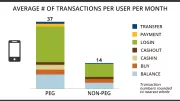Recent Blogs
Blog
To the Future and Back: Financial Inclusion in the Arab World
A new Arab Monetary Fund-CGAP report points to a huge unmet demand for financial services in the Arab world, where 70 percent of adults lack access to an account.Blog
How Social Norms Affect Women’s Financial Inclusion
Four in 10 women and girls around the world are excluded from the formal financial system. Restrictive social norms are one major factor that limits women's financial inclusion. Here's why norms matter.Blog
5 Keys to Addressing the Needs of API Consumers
Learn about five steps digital financial services providers can take to design open API products that appeal to third-party developers in their markets.Blog
From Theory to Practice in the Market Facilitation Approach
Market facilitation has become a well-known approach to development, but evidence on how best to apply it in the field remains limited. New case studies from Africa point toward numerous lessons.Blog
Daily Energy Payments Powering Digital Finance in Ghana
New evidence from Ghana suggests that pay-as-you-go solar customers are becoming more active mobile money users.Blog
Market Facilitation: Unpacking New Evidence from Africa
Market facilitation has become a common approach to making financial markets work for the poor. This post kicks off a new series to explore how this approach can be used effectively.Blog
Will Brazil Go Digital?
Small and medium banks in Brazil are starting to take advantage of new regulations that make it easier to adopt fully digital business models. What impact might this development have on financial inclusion in the longer term?Blog
Will Universal Basic Income Replace Safety Net Payments in India?
India is currently considering a universal basic income (UBI) scheme in which the government would guarantee a minimum income for all citizens. What are the key points of the UBI debate? What could UBI mean for financial inclusion in India?Blog
5 Challenges for Women’s Financial Inclusion
From restrictive cultural norms to less access to technology, women around the world face unique challenges in gaining access to formal financial services.Blog
Responsible Digital Credit for Merchants: Insights from Kenya
As digital credit expands rapidly in East Africa and elsewhere, offering credit responsibly is becoming increasingly important. These insights from Kenyan merchants who use Kopo Kopo’s Grow cash advance product point toward some best practices for digital merchant credit.Blog
How to Better Serve Customers: Insights from 5 Research Projects
CGAP's Customers at the Center Research Fund has generated insights about the world’s unbanked over the past two years. Here are the top insights from the Fund’s five projects and the lessons we have learned.Blog
Are Open Platforms Smart Business for Payments Providers?
Many industries have seen businesses grow after opening APIs. Learn why open APIs could also be a boon for financial services providers in emerging markets.Blog
The SDGs and CGAP’s Future Direction
The approval of the SDGs in September 2015 coincided with CGAP’s organizational strategy refresh. While this strategic thinking process is still ongoing, here are three clear directions for CGAP's future work that build on the themes in the SDGs.Blog
India Has Built the Rails — Will Passengers Climb Aboard?
India has put in place virtually all of the supply-side factors that should make low-cost financial services available for all. But the big question right now is the customer. The next year will be telling in how the adoption of digital financial services unfolds.Blog
All’s Well That Repays Well? Not Necessarily.
The rapid growth of microfinance in India has led to concerns about a repayment crisis. Some have tempered these worries by pointing to low delinquency rates. But do low delinquency rates tell the whole story?Blog
Why Does M-PESA Lift Kenyans Out of Poverty?
New research shows that access to basic financial services via M-PESA made a difference in Kenya, lifting 2 percent of households out of poverty. Were mobile phones or proximity to agents crucial elements driving the change?Blog
3 Customer Insights for Better Mobile Money UI/UX in Pakistan
Smartphone use in Pakistan has grown steadily, but low-income, less educated, and female customers lag in smartphone adoption and ownership. GRID Impact's user research lends insights into how to better serve and design for these population segments.Blog
Can Financial Inclusion Change Gender Norms?
What does women's economic empowerment look like? Increasingly, researchers and practitioners are focusing on two parallel approaches: Alleviating the symptoms of social and gender norms to enhance access to finance, and potentially changing prevailing gender norms themselves.Blog
RegTech: Are Supervisors Ready for the Data Revolution?
Technology and data are considered the engine of new financial disruption. FinTech's lesser-known sibling, RegTech, refers to technology that can improve efficiency, consistency, and ease of supervisory processes. What does this revolution look like?Blog




















